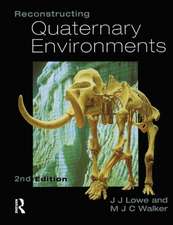Biochronological Correlations
Autor Jean Guex Traducere de B. Burke-Hubbarden Limba Engleză Paperback – 28 oct 1991
Preț: 641.03 lei
Preț vechi: 754.15 lei
-15% Nou
Puncte Express: 962
Preț estimativ în valută:
122.66€ • 128.75$ • 101.81£
122.66€ • 128.75$ • 101.81£
Carte tipărită la comandă
Livrare economică 10-24 aprilie
Preluare comenzi: 021 569.72.76
Specificații
ISBN-13: 9783540539377
ISBN-10: 3540539379
Pagini: 272
Ilustrații: XIV, 252 p. 1 illus.
Dimensiuni: 170 x 242 x 14 mm
Greutate: 0.44 kg
Ediția:Softcover reprint of the original 1st ed. 1991
Editura: Springer Berlin, Heidelberg
Colecția Springer
Locul publicării:Berlin, Heidelberg, Germany
ISBN-10: 3540539379
Pagini: 272
Ilustrații: XIV, 252 p. 1 illus.
Dimensiuni: 170 x 242 x 14 mm
Greutate: 0.44 kg
Ediția:Softcover reprint of the original 1st ed. 1991
Editura: Springer Berlin, Heidelberg
Colecția Springer
Locul publicării:Berlin, Heidelberg, Germany
Public țintă
ResearchCuprins
1 Properties of Biochronologic Scales.- 1.1 Introduction.- 1.2 Properties of Discrete Scales.- 1.3 Ideal Referentials.- 1.4 Protoreferentials.- 1.5 Chronologic Interpretation of a Protoreferential.- 1.6 Discrete Biochronologic Scales.- 2 Semiempirical Construction of a Referential.- 2.1 Introduction.- 2.2 Definitions.- 2.3 Method.- 2.4 Example of Application.- 2.5 Summary.- 3 Biochronologic Referentials and Graph Theory.- 3.1 Representing Stratigraphic Relationships.- 3.2 Definitions.- 3.3 Descriptive and Technical Terms: Definitions.- 3.4 Interval Graphs.- 3.5 Maximal Cliques and Unitary Associations.- 3.6 Summary of Methodology.- 3.7 Summary of Notations.- 3.8 A Concrete Problem: the Ilerdian Alveolinid from Yugoslavia.- 4 Transforming a Biostratigraphic Graph.- 4.1 Introduction.- 4.2 Searching for Virtual Coexistences.- 4.3 Detecting Circuits and Cycles of G.- 4.4 Adding Virtual Edges to G.- 5 Protoreferentials, Referentials, and Correlations.- 5.1 Introduction.- 5.2 Construction of Unitary Associations.- 5.3 Seriation of Unitary Associations.- 5.4 Graph Gk and Protoreferential.- 5.5 Identifying Unitary Associations.- 5.6 Optimal Biochronologic Subdivisions.- 6 The BioGraph Program.- 6.1 Introduction.- 6.2 Conventions and Definitions.- 6.3 Method.- 6.4 Example of Application of BioGraph.- 7 Detecting Reworking.- 7.1 Introduction.- 7.2 Definitions.- 7.3 Methods.- 7.4 Conclusion to the Alveolinid Problem.- 7.5 Conclusion to the Reworking Problem.- 8 Quality of the Fossil Record.- 8.1 Introduction.- 8.2 Definitions.- 8.3 Coefficients.- 8.4 Relationships Between the Coefficients.- 9 Contradictory Biochronologic Correlations.- 9.1 The Lower Triassic of the Salt Ranges.- 9.2 Lithostratigraphic Framework and Ammonite Zones.- 9.3 Stratigraphic Distribution of Conodonts.- 9.4Biochronologic Interpretation.- 9.5 Discussion.- 10 Transgressive/Regressive Cycles.- 10.1 Paleogene Benthic Foraminifera from Mississippi and Alabama.- 10.2 Preliminary Remarks.- 10.3 Database.- 10.4 Unitary Associations and Correlations.- 10.5 Stratigraphic Interpretation.- 10.6 Quality of the Fossil Record of Species.- 10.7 Complexity of the Problem.- 10.8 An Example of Integrated Biochronology.- 11 Diachronous Datums.- 11.1 Paleogene Nannoplankton from California.- 11.2 Database.- 11.3 Correlations and Zonation.- 11.4 First Conclusions.- 11.5 Biochronologic Dispersion of Datums.- 11.6 Comparison with Deboo’s Data.- 11.7 Complexity of the Problem.- 11.8 Constructing a Sequence of Datums.- 12 Diachronism of LADs: Possible Causes.- 12.1 Introduction.- 12.2 Mediterranean Neogene Nannoplankton.- 12.3 Comparison with Californian Nannoplankton.- 12.4 Conclusion.- 13 Age of Tethyan Radiolarites.- 13.1 A Difficult Geological Problem.- 13.2 Radiolarian Zones in the Tethyan Realm.- 13.3 Biochronologic Correlations and Geologic Interpretation.- 13.4 Rates of Faunal Turnover.- 14 Unitary Associations and Ammonite Zones.- 14.1 Introduction.- 14.2 Original Data.- 14.3 Zonation.- 14.4 Precision of the Method.- 14.5 Problematic Virtual Coexistences.- 14.6 Paleontological Notes.- 15 Quantitative Biostratigraphy.- 15.1 General Remarks.- 15.2 Multivariate Approaches.- 15.3 Probabilistic Approaches.- 15.4 Deterministic Approaches.- 15.5 Comparison of Range Charts.- 16 Zones, Stratotypes, and Controversies.- 16.1 Introduction.- 16.2 Oppel Zones and Unitary Associations.- 16.3 Phylogenetic Sedations and Phylozones.- 16.4 Oppel Zone, Interval Zone, and Datums.- 16.5 Standard Zones.- 16.6 Acme Zones and Peak Zones.- 16.7 Stratotypes.- 16.8 Integrated Biochronology and Calibration.- 16.9Validity of a Zone.- Appendices.











